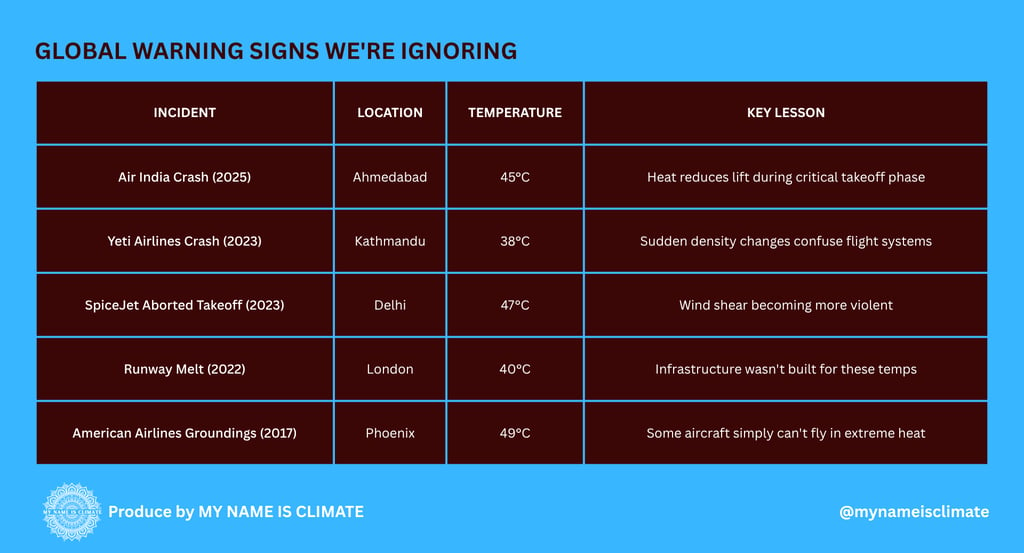Air India Boeing 787 Crash: A Climate Change Warning
The tragic Air India Boeing 787 crash in Ahmedabad in June 2025 underscores the dangers of climate change on aviation safety. With soaring temperatures reaching 45°C (113°F) at takeoff, this disaster highlights the urgent need to address global warming and its implications for air travel.
FLIGHT CRASH
Lalit Bhusal
6/16/20252 min read


The Scorching Truth: Planes Can't Handle This Heat
When Air India's Boeing 787 Dreamliner crashed in Ahmedabad on June 12, the aviation world got a terrifying wake-up call. With temperatures hitting 45°C (113°F) at takeoff, this tragedy exposes a frightening reality: climate change is rewriting the rules of flight safety.
But Ahmedabad isn't alone. From Phoenix to Kathmandu, airports worldwide are becoming danger zones as temperatures soar beyond aircraft design limits. Here's why your next flight might be riskier than you think.
6 Climate Threats Crashing the Aviation Industry
1. "Hot and High" Airports Turning Deadly
Ahmedabad (189 ft elevation): Runway temps exceeded 50°C (122°F) during crash
Phoenix (2017): 40+ flights canceled at 49°C (120°F)
Delhi (777 ft): Multiple near-misses at 47°C+
Leh (10,682 ft): Summer weight restrictions now standard
Shocking Fact:
By 2050, 1 in 3 flights may face weight restrictions
due to heat (MIT, 2025).
2. Jet Engines Gasping for Air
Every 3°C rise = 1% thrust loss (Boeing data)
2024 Emirates Incident: A380 forced to turn back over Saudi desert when engines couldn't maintain altitude
Ahmedabad Crash: Preliminary reports indicate possible combined engine underperformance + wind shear
3. Runways Literally Falling Apart
London Luton (2022): Runway buckled at 40°C (104°F)
Chennai (2024): Flights delayed after asphalt softened at 48°C
Jaipur: Surface temps regularly hit 60°C (140°F)
Solution? Phoenix now paints runways light gray (reduces temp by 10°C)
4. The Invisible Killer: Heat Turbulence
Turbulence injuries tripled since 1980 (NCAR)
2025 Singapore Airlines Incident: 22 injured over Bay of Bengal
Indian airspace seeing 17% more severe turbulence than a decade ago
5. Pilots Flying Blind Into New Weather Extremes
70% of Indian pilots report unprecedented wind shear (2024 survey)
Monsoon turbulence 30% stronger (IMD)
Most simulators use outdated weather models
6. The Pre-Flight Prep Crisis
Weight Calculations Using Obsolete Data
Airlines still input "standard day" temps (15°C) into performance calculators
2023 SpiceJet incident: Generic charts used despite 47°C heat
Boeing Flight Guidance (BFG) Ignored
What’s SkippedClimate RiskAssumed temp method misuseUnderestimates thrust needsEngine-out proceduresDoesn’t account for heat thrust lossTOPIC calculator errorsUrban heat islands distort inputs
Retired 787 Pilot’s Warning:
"We treat BFG as emergency-only. Now, every hot takeoff needs BFG-level precision."
Who’s Failing?
✅ Dispatchers: Using old weather models
✅ Pilots: Skipping full performance reviews
✅ Airports: Not sharing real-time tarmac temps


The Looming Crisis: What's Not Being Done
✅ Partial Solutions:
Air India now restricts Dreamliner takeoffs above 42°C
Singapore installing real-time runway sensors
Qatar Airways bans certain takeoffs above 45°C
❌ Critical Gaps:
No updated maximum operating temps for modern aircraft
1950s-era runway designs still standard at Indian airports
70% of flight simulators use pre-2010 weather models
Most alarming? The ICAO predicts climate-related aviation incidents will quadruple by 2030.
How to Protect Yourself
Fly early/late: Avoid midday summer departures
Choose larger aircraft: Better heat tolerance
Check wind shear alerts: Especially May-September
Watch for notices: Airlines increasingly cancel overheated flights
Final Warning
The Ahmedabad crash wasn't just "bad luck"—it was climate change eroding aviation's safety margins. Until airlines and regulators face this new reality, every extreme heat day becomes a roll of the dice at 30,000 feet.
Share this investigation: Most travelers don't realize they're flying in conditions these planes were never designed for.
References:
MIT Aeronautics Lab (2025)
Boeing Thermal Performance Reports
ICAO Climate Advisory (2024)
Indian Meteorological Department
Have you experienced extreme heat flights? Share your story by email to us: mynameisclimate@gmail.com
(Follow Climate Foundation for more hard-hitting climate risk analysis @mynameisclimate)


